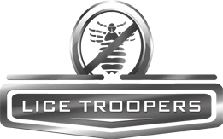If your child comes home with an itchy head, your first instinct as a parent may be to check for lice. But how can you do that if you’re not sure what lice look like? We found an article by premium lice treatment providers Lice Troopers that delineates what lice look like. We’ve separated it into 5 main points to enable parents to know what to look for.
1) Lice look differently depending on what stage of the life cycle they’re in.
Lice Troopers starts by informing us that the head louse will look slightly different depending on the stage of its life cycle it’s currently in. This parasitic, wingless insect has 3 life stages: the egg or nit stage, the nymph stage, & the adult louse stage.
A head louse starts off as a nit, the term used for a louse egg. They appear either white, dear, or brown depending on whether or not the unborn louse remains in the egg or not. Before hatching, it appears brown and once hatched, it looks white or clear. Once hatched, the nymph looks just like an adult louse, just smaller. And when it has reached adulthood, the louse is about the size of a sesame seed. It has 6 legs like any insect. To see a picture for reference, check out Lice Trooper’s article.
2) Lice have a different color & pattern of behavior than dandruff.
People often mistake head lice for dandruff and vice versa. We need to be able to differentiate the two, as dandruff causes far less harm.
The two conditions come from vastly different origins. While lice bites result from a parasite infestation on your scalp, dandruff originates from an oily scalp that leads to a fungal infection. You can tell them apart pretty easily when you know what to look for. If the white spots flake off easily, you likely have a simple case of dandruff, medically termed seborrheic dermatitis. If the spots stick to your hair and don’t flake off easily, then you’ve possibly found nits from a lice infestation. Lice Troopers has written another in-depth article with tips to help parents make this distinction.
Color also helps you to tell lice/nits apart from dandruff. You’ll generally see white flakes as evidence for dandruff and yellow, tan, or brown spots as evidence for nits. Also note that lice will look lighter in blonde hair and darker in brunettes.
You can usually treat dandruff by washing your chair more often, Lice Troopers has told us. You will also find effective home remedies such as diluted tea tree oil, aloe vera, or apple cider vinegar. If these solutions fail you, consult your dermatologist.
3) We can see lice with our bare eyes even though they’re very small.
Lice Troopers reveals that lice, though very small, can indeed be seen by our bare eyes. As adults, they reach somewhere from 2mm to 3mm in length.
Although they’re visible to us, parasitic lice move around sneakily and can escape our gaze. Nits can get lost as they’re a mere 0.8mm in length. And adult lice move around fast, so try using a magnifying glass to see them.
4) If you can’t find lice but still think you’re infested, check for lice bites.
We’ve determined what lice look like, but what about the itchy bites they leave behind? Perhaps you don’t have a magnifying glass or simply can’t find lice or nits even though you have a suspicion that you’re infested.
Consider 3 things when looking:
- They prefer warm areas with lots of hair & remain where hair meets follicle
- Look for inflamed, bright red blotches (possibly infected)
- Found no blotches? Check for small, pink spots
Lice leave saliva behind when biting you, generally causing small allergic reactions. They present as small, slightly red spots. These may become infected after scratching and even lead to open sores—looking more red and larger. Since lice prefer warm & hidden environments, check near the neck, behind the ears, or even at the base of where ponytails would be in longer hair.
5) You can check your child or yourself for lice, but if you want to be quicker and completely sure, see a professional.
Parents become understandably frustrated when an itchy child comes home, and they’re unsure whether this itchiness stems from lice or simply dandruff or even a dry scalp. Children contract lice more often, and luckily, parents can check their sons or daughters with more ease than themselves.
Start by shining a bright light above your son or daughter’s head. Search near the scalp for little crawling insects or nits attached to their hair shaft—matching the descriptions above. Next, use a fine-tooth comb to part their hair both from side to side & from top to bottom. Take special note of hair at the nape of the neck and behind the ears or other warm areas, as they prefer such spots. Remember to check bun or ponytail areas as these match the warm and hairy characteristics they prefer. You’ll need to repeat this process across your child’s entire head, which can take several hours.
Even then, as parents aren’t professionals, it’s easy to miss nits or an adult louse. Unfortunately, even one of these will lead to an infestation if not treated.
To go through the process more quickly and be sure of your results, see professionals such as Lice Troopers for a screening and treatment if necessary.
